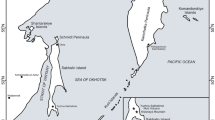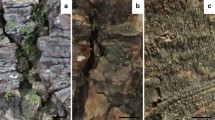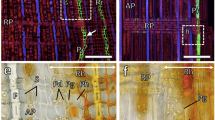Abstract
Key message
The collapse of some cell types and the simultaneous growth or expansion of others hinder the estimation of the contribution of individual tissues to the variation of bark dimension over time.
Abstract
Information on the spatio-temporal pattern of secondary changes occurring in older bark, as well as the activity of phellogen and the development of periderm is still relatively scarce. Anatomical and histometrical investigations were carried out on the bark of mature Quercus petraea growing in Ljubljana, Slovenia. The bark of the oaks was on average 19 mm thick, with the inner bark and the rhytidome accounting for 39 and 61 %, respectively. A high correlation was found between the widths of the rhytidome and of the entire bark, but a fairly weak one between inner bark and entire bark. The youngest phloem increment on average represented around 5 % of the inner bark and around 2.1 % of the entire bark. Growth-ring boundaries were not distinguishable in the collapsed phloem; however, counting the phloem increments was possible due to the presence of phloem fibres at the transition from early to late phloem. We also followed the spatial–temporal secondary changes in collapsed phloem tissue. Phloem increment development in Q. petraea showed that patterns of phloem formation at one location remained practically unchanged in different years. The relationship between processes occurring in different bark tissues is not linear. In addition to the high variability in bark, the collapse of some cell types and the simultaneous growth or expansion of others hinder the estimation of the contribution of individual tissues to the variation of bark dimension over time.










Similar content being viewed by others
References
Alfieri FJ, Evert RF (1968) Seasonal development of the secondary phloem in Pinus. Am J Bot 55:518–528
Arzee T, Kamir D, Cohen L (1978) On the relationships of hairs to periderm development in Quercus ithaburensis and Q. infectoria. Bot Gaz 139:95–101
Deslauriers A, Morin H, Urbinati C, Carrer M (2003) Daily weather response of balsam fir (Abies balsamea (L.) Mill.) stem radius increment from dendrometer analysis in the boreal forests of Quebec (Canada). Trees Struct Funct 17:477–484
Esau K (1939) Development and structure of the phloem tissue. Bot Rev 5(7):373–432. doi:10.1007/BF02878295
Evert RF (2006) Esau’s plant anatomy meristems, cells, and tissues of the plant body: their structure, function, and development. Wiley, Hoboken
Fonti P, García-González I (2004) Suitability of chestnut earlywood vessel chronologies for ecological studies. New Phytol 163:77–86
Friedrichs DA, Neuwirth B, Winiger M, Löffler J (2009) Methodologically induced differences in oak site classifications in a homogeneous tree-ring network. Dendrochronologia 27(1):21–30
Gozdnogospodarski načrt gozdnogospodarske enote Krakovo 2006–2015 (Forest management plan for Forest Management Unit Krakovo 2006–2015) (2006) Zavod za gozdove Slovenije, območna enota Brežice. Brežice
Graça J, Pereira H (2004) The periderm development in Quercus suber. IAWA J 25(3):325–335
Gričar J (2007) Xylo- and phloemogenesis in silver fir (Abies alba Mill.) and Norway spruce (Picea abies (L.) Karst.), vol 132. Studia Forestalia Slovenica, Slovenian Forestry Institute, Ljubljana
Gričar J (2010) Xylem and phloem formation in sessile oak from Slovenia in 2007. Wood Res 55(4):15–22
Gričar J, Jagodic Š, Šefc B, Trajković J, Eler K (2014) Can the structure of dormant cambium and the widths of phloem and xylem increments be used as indicators for tree vitality? Eur J Forest Res 133:551–562. doi:10.1007/s10342-014-0784-8
Holdheide W (1951) Anatomie mitteleuropäischer Gehölzrinden. In: Freud H (ed) Handbuch der Mikroskopie in der Technik. Umschau Verlag, Frankfurt am Main, pp 193–367
Howard ET (1977) Bark structure of southern upland oaks. Wood Fiber Sci 9(3):172–183
Larson PR (1994) The vascular cambium: development and structure. Springer, Berlin
Lev-Yadun S, Liphschitz N (1989) Sites of first phellogen initiation in conifers. IAWA Bull 10(1):43–52
Miranda I, Gominho J, Pereira H (2013) Cellular structure and chemical composition of cork from the Chinese cork oak (Quercus variabilis). J Wood Sci 59(1):1–9. doi:10.1007/s10086-012-1300-8
Pereira H (1988) Chemical composition and variability of cork from Quercus suber L. Wood Sci Technol 22:211–218
Pereira H (2013) Variability of the chemical composition of cork. BioResources 8(2):2246–2256
Prislan P, Koch G, Schmitt U, Gričar J, Čufar K (2012) Cellular and topochemical characteristics of secondary changes in bark tissues of beech (Fagus sylvatica). Holzforschung 66(1):131–138. doi:10.1515/HF.2011.119
Prislan P, Gričar J, de Luis M, Smith KT, Čufar K (2013) Phenological variation in xylem and phloem formation in Fagus sylvatica from two contrasting sites. Agr Forest Meteorol 180:142–151. doi:10.1016/j.agrformet.2013.06.001
Quilhó T, Sousa V, Tavares F, Pereira H (2013) Bark anatomy and cell size variation in Quercus faginea. Turk J Bot 37:561–570. doi:10.3906/bot-1201-54
Rossi S, Anfodillo T, Menardi R (2006) Trephor: a new tool for sampling microcores from tree stems. IAWA J 27:89–97
Şen A, Miranda I, Santos S, Graça J, Pereira H (2010) The chemical composition of cork and phloem in the rhytidome of Quercus cerris bark. Ind Crop Prod 31:417–422
Şen A, Quilhó T, Pereira H (2011a) Bark anatomy of Quercus cerris L. var. cerris from Turkey. Turk J Bot 35:45–55. doi:10.3906/bot-1002-33
Şen A, Quilhó T, Pereira H (2011b) The cellular structure of cork from Quercus cerris var. cerris bark in a materials’ perspective. Ind Crop Prod 34:929–936
Srivastava LM (ed) (1964) Anatomy, chemistry, and physiology of bark. Academic Press, New York
Trockenbrodt M (1990) Survey and discussion of the terminology used in bark anatomy. IAWA Bull 11(2):141–166
Trockenbrodt M (1991) Qualitative structural changes during bark development in Quercus robur, Ulmus glabra, Populus tremula and Betula pendula. IAWA Bull 12(1):5–22
Trockenbrodt M (1994) Quantitative changes of some anatomical characters during bark development in Quercus robur, Ulmus glabra, Populus tremula and Betula pendula. IAWA Bull 15:387–398
Trockenbrodt M (1995a) Calcium oxalate crystals in the bark of Quercus robur, Ulmus glabra, Populus tremula and Betula pendula. Ann Bot 75:281–284
Trockenbrodt M (1995b) Structure and identification of root bark of Quercus robur L. Trees Struct Funct 9:341–347
van der Werf GW, Sass-Klaassen U, Mohren GMJ (2007) The impact of the 2003 summer drought on the intra-annual growth pattern of beech (Fagus sylvatica L.) and oak (Quercus robur L.) on a dry site in the Netherlands. Dendrochronologia 25:103–112
Whitmore TC (1963) Studies in systematic bark morphology. IV. The bark of beech, oak and sweet chestnut. New Phytol 62(2):161–169
Zweifel R, PrometheusWikicontributors (2011) Stem radius fluctuations of trees. Prometheus Wiki. Accessed 14 Aug 2014
Zweifel R, Zimmermann L, Zeugin F, Newbery DM (2006) Intra-annual radial growth and water relations of trees: implications towards a growth mechanism. J Exp Bot 57(6):1445–1459. doi:10.1093/jxb/erj125
Zweifel R, Eugster W, Etzold S, Dobbertin M, Buchmann N, Häsler R (2010) Link between continuous stem radius changes and net ecosystem productivity of a subalpine Norway spruce forest in the Swiss Alps. New Phytol 187:819–830
Author contribution statement
J.G. together with P.P. developed the concept of the paper, wrote the paper, prepared the cross-sections and performed the wood-anatomical analysis, Š.J. prepared the figures, performed the wood-anatomical measurements, P.P. helped to develop the concept of the paper, helped to prepare the figures and measurements, wrote some parts of the results and discussion.
Acknowledgments
The authors would like to thank the anonymous reviewers for their valuable comments and suggestions to improve the quality of the paper. The work was supported by the Slovenian Research Agency, program P4-0107 and project Z4-9662 and by EUFORINNO (RegPot No. 315982) of the FP7 Infrastructures programme. The authors would like to acknowledge the contribution of the COST Action FP1106, STReESS. We thank Martin Cregeen for language editing.
Conflict of interest
The authors declare that they have no conflict of interest.
Author information
Authors and Affiliations
Corresponding author
Additional information
Communicated by M. Shane.
Rights and permissions
About this article
Cite this article
Gričar, J., Jagodic, Š. & Prislan, P. Structure and subsequent seasonal changes in the bark of sessile oak (Quercus petraea). Trees 29, 747–757 (2015). https://doi.org/10.1007/s00468-015-1153-z
Received:
Revised:
Accepted:
Published:
Issue Date:
DOI: https://doi.org/10.1007/s00468-015-1153-z




